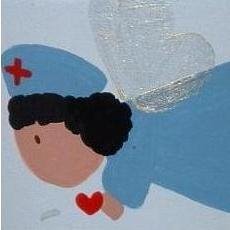august start ng new batch of trainees sa qcgen. 2,400 pesos for 6 mos., rotational basis including special areas. for more info call 4261314, pa-connect mo nalang sa training office.
Friday, May 30, 2008
Wednesday, May 28, 2008
Anti-Microbial Drugs
Tetracyclines:
Tetracycline
Doxycycline
Minocycline
Demeclocycline
Macrolides:
Carithormycin
Erythromycin
Azithromycin
Aminoglycosides:
Amikacin
Gentamicin
Neomycin
Tobramycin
Streptomycin
Protein Synthesis Inhibitors:
Chloramphenicol
Aminoglycosides
Tetracyclines
TB Medications:
Isoniazid
Rifampin
Ethambutol
Pyrazinamide
Ethambutol
Fluoroquinolones:
Ciprofloxacin
Sparfloxacin
Enaxacin
Nalidixic acid
Norfloxacin
Mortifloxacin
Sulfonamides:
Sulfadiazine
Sulfisoxazole
Sulfamethoxazole
Malaria Treatment:
Chlorquine
Quinine
Mefloquine
Additional Mentionable Anti-viral Drugs:
Acyclovir
Amatadine
Ribavirin
Zanamivir
Ganciclovir
HIV Treatment:
Zidovudine (AZT)
Nevirapine
Didanosine
Protease Inhibitors-(HIV)
Saquinavir
Retinonavir
Nelfinavir
Sunday, May 25, 2008
Asthma Treatment
Corticosteroids:
Prednisone
Beclomethasone
Antileukotrienes:
Zafirlukast
Zileuton
Beta 2 agonists:
Salmeterol
Albuterol
Nonselective Beta agonists:
Isoproterenolol
Muscarinic agonists:
Ipratropium
H2 blockers:
Famotidine
Nizatidine
Cimetidine
Ranitidine
Monday, May 19, 2008
Musculoskeletal Review
Legg-Calve-Perthes disease: poor blood supply to the superior aspect of the femur. Most common in boys ages 4-10. The femur ball flattens out and deteriorates. 4x higher incidence in boys + Bony cresent sign.
Developmental dysplasia of the hip: abnormal development of the hip joint found that is congenital.
Slipped capital femoral epiphysis: 2x greater incidence in males, most common hip disorder in adolescents. The ball of the femur separates from the femur along the epiphysis.
Polymyalgia Rheumatica- hip or shoulder pain disorder in people greater than 50 years old.
Systemic lupus erythemtosus: autoimmune disorder that affects joints, skin and various organ systems. Chronic and inflammatory. 9x more common in females. Butterfly rash
Scleroderma: connective tissue disease that is diffuse.
Rheumatoid Arthritis: inflammatory autoimmune disease that affects various tissues and joints.
Juvenile Rheumatoid Arthritis: inflammatory disease that occurs in children.
Paget’s disease: abnormal bone development that follows bone destruction. The disease is characterized by excessive breakdown of bone tissue, followed by abnormal bone formation. The new bone is structurally enlarged, but weakened and filled with new blood vessels.
Osteoarthritis: chronic condition affecting the joint cartilage that may result in bone spurs being formed in the joints. Morning stiffness
Gout: uric acid development in the joints causing arthritis.
Fibromyalgia: joint, muscle and soft tissue pain in numerous locations. Presence of tender points and soft tissue pain.
Duchenne muscular dystrophy: Genetically X-linked recessive type of muscular dystrophy that starts in the lower extremities. Dystrophin-protein dysfunction.
Ankylosing spondylitis: Vertebrae of the spine fuse. A type of arthritis that causes chronic inflammation of the spine and the sacroiliac joints. Chronic inflammation in these areas causes pain and stiffness in and around the spine. Over time, chronic spinal inflammation (spondylitis) can lead to a complete cementing together (fusion) of the vertebrae, a process called ankylosis. Ankylosis causes total loss of mobility of the spine.
Compartment syndrome: impaired blood flow and nerve dysfunction caused by nerve and blood vessel compression.
Osteosarcoma: bone tumor that is malignant and found in adolescents.
Monday, May 12, 2008
Cancer Treatment Drugs
Etoposide
Nitrosoureas
Cisplatin
Doxorubicin
Incristine
Paclitaxel
Methotrexate
6 – mercaptopurine
Busulfan
5 – fluorouracil
Lomustine
Carmustine
Glaucoma Treatment:
Prostaglandins
Diuretics
Alpha agonists
Beta Blockers
Throbolytics:
Urokinase
Anistreplase
Streptokinase
Alteplase
Cox 2 Inhibitors:
Rofecoxib
Celecoxib
NSAID’s:
Naproxen
Indomethacin
Ibuprofen
Diabetic Treatment:
Sulfonylureas:
Chlorpropamide
Tolbutamide
Glyburide
Glitazones:
Rosiglitazone
Troglitazone
Pioglitazone
Insulin- Key
Infolinks In Text Ads
Disclaimer
If you see any inaccuracy in the questions and answers please help us correct it by commenting below any posts.
Read more at Nurseslabs.com http://nurseslabs.com/disclaimer/#_
Read more at Nurseslabs.com http://nurseslabs.com/disclaimer/#_
Read more at Nurseslabs.com http://nurseslabs.com/disclaimer/#_









